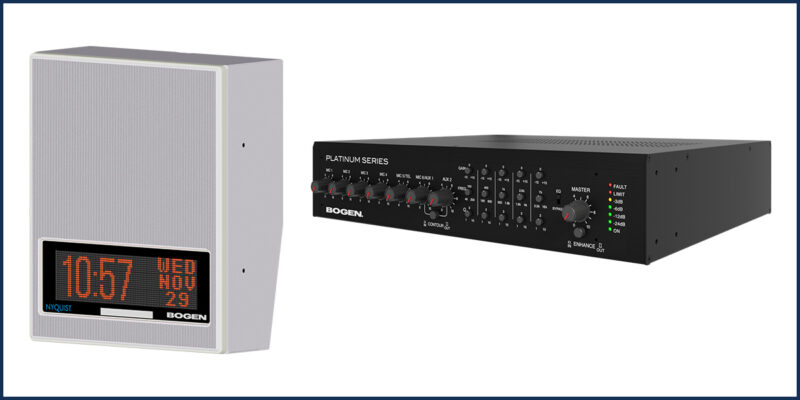Enhancing Communication and Safety by Leveraging IP-based Paging and Intercom Systems

BY: RANDALL LEE
As the world continues to embrace digital transformation, the evolution of IP-based paging and intercom systems is enhancing communication, safety and efficiency within facilities. Modern advancements are revolutionizing traditional public address systems, making them more versatile and responsive to dynamic and emergent situations.
The shift to IP-based technology is an advancement from the conventional methods where public address systems were limited by physical connections. Previously, triggering a pre-recorded announcement required manual interventions through button pushes and relays, which could delay critical response times. Today, IP-based systems enable facilities to integrate seamlessly with third-party event detection solutions via APIs, creating a unified and automated emergency response network.

Bogen’s Nyquist E7000 and C4000 systems
utilize modern software to meet the complex needs of today’s educational and commercial
environments and are constantly evolving to meet customer needs.
This integration is a game-changer in safety and security protocols. Providers of IP-based public address systems actively collaborate with solutions that detect emergency situations, such as weapon detection, gunshots, earthquakes, natural disasters and intrusions.
These partnerships facilitate automated mass notifications, significantly reducing the time taken to inform and protect individuals during crises. For example, in the event of an active shooter, an integrated system can instantly trigger a lockdown, issue specific instructions, and provide real-time location information, thereby enhancing the overall safety response.
To fully leverage the benefits of IP-based paging and intercom systems, it is essential to follow best practices that ensure optimal performance and integration. Here are some key recommendations:
- Assess Needs and Objectives: Begin by evaluating the specific needs and objectives of the facility. Understanding the unique requirements will guide the selection and implementation of the appropriate IP-based system. Consider factors such as the size of the facility, the number of occupants and the types of emergencies most likely to occur.
- Ensure Network Robustness: IP-based systems rely heavily on network infrastructure. Ensure the network is robust, secure and capable of handling the additional load. This includes having adequate bandwidth, redundancy and cybersecurity measures in place to protect against potential threats.
- Integration with Third-Party Systems: Maximize the functionality of an IP-based system by integrating it with third-party event detection and response solutions. This includes collaboration with providers of emergency detection technologies to create a comprehensive and automated emergency response plan.
- Regular Testing and Maintenance: To ensure reliability, conduct regular testing and maintenance of your IP-based systems. This includes routine checks of the network, hardware and software components to identify and address any issues promptly.
- Training and Awareness: Educate staff and occupants on the functionality and usage of the IP-based paging and intercom systems. Conduct regular drills and training sessions to ensure everyone is familiar with the procedures during an emergency.
As IP-based paging and intercom systems evolve, their ability to interface with diverse safety platforms will become increasingly critical. Looking forward, advancements in artificial intelligence and machine learning will likely enhance the capabilities of IP-based systems. These technologies can provide more accurate and timely responses by analyzing vast amounts of data in real-time, leading to more effective communication and safety protocols.
In conclusion, embracing IP-based paging and intercom systems, along with third-party integrations, is essential for modern meeting spaces and classrooms. By following best practices and staying abreast of technological advancements, facilities can significantly enhance their communication, safety and overall efficiency.
 About the Author: Randall Lee has extensive experience in marketing and product management. As vice president of marketing and product management at Bogen Communications, Lee has played a key role in driving the company’s growth and establishing its position as a market leader. Before joining Bogen, Lee was the marketing content manager at Universal Robots A/S, where he managed global demand generation through content creation and distribution. Lee has also worked with other industry brands such as Yamaha Unified Communications, Sensata Technologies, TEL Epion and Keithley Instruments.
About the Author: Randall Lee has extensive experience in marketing and product management. As vice president of marketing and product management at Bogen Communications, Lee has played a key role in driving the company’s growth and establishing its position as a market leader. Before joining Bogen, Lee was the marketing content manager at Universal Robots A/S, where he managed global demand generation through content creation and distribution. Lee has also worked with other industry brands such as Yamaha Unified Communications, Sensata Technologies, TEL Epion and Keithley Instruments.




